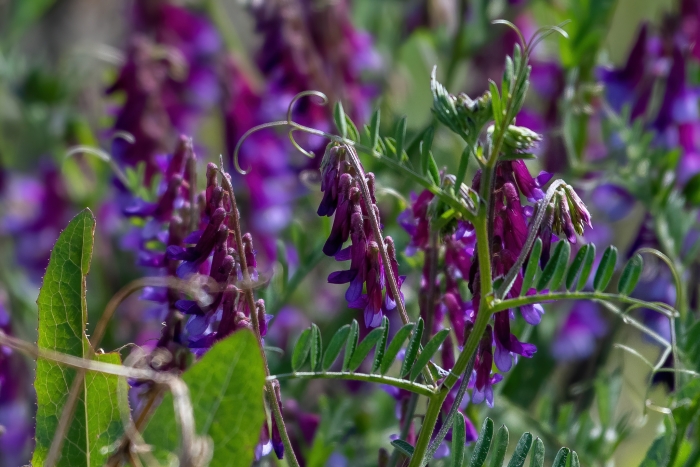Hairy Vetch
(Vicia villosa)
Hairy Vetch (Vicia villosa)
/
/

Jonathan Eisen
CC BY 4.0
Image By:
Jonathan Eisen
Recorded By:
Copyright:
CC BY 4.0
Copyright Notice:
Photo by: Jonathan Eisen | License Type: CC BY 4.0 | License URL: http://creativecommons.org/licenses/by/4.0/ | Rights Holder: Jonathan Eisen | Publisher: iNaturalist | Date Created: 2020-03-10T14:46:28-07:00 |
























Estimated Native Range
Summary
Vicia villosa, commonly known as hairy vetch, is an annual or short-lived perennial legume native to Europe and western Asia, particularly thriving in open areas such as grasslands and fields. It has been introduced to North America, where it is often used in agriculture but can be invasive in certain regions, including Alaska, Florida, and Michigan. Hairy vetch typically reaches a height of 1 to 2 feet and has a vining growth habit, with stems that can extend up to 6 feet long. It produces small, purple to violet flowers in the late spring and early summer, which are moderately showy and beneficial for pollinators.
Hairy vetch is valued for its ability to fix significant amounts of atmospheric nitrogen, up to 200 lb/acre, making it a popular choice for organic farming as a cover crop and green manure. It is also used for soil erosion control and as forage for livestock. In cultivation, it prefers full sun to part shade and grows best in well-drained soils, though it is tolerant of a range of soil types. While it can be a useful plant, hairy vetch requires careful management to prevent it from becoming weedy and potentially invasive outside its native range. It is recommended to consult local guidelines before planting to ensure it is not problematic in your area.CC BY-SA 4.0
Hairy vetch is valued for its ability to fix significant amounts of atmospheric nitrogen, up to 200 lb/acre, making it a popular choice for organic farming as a cover crop and green manure. It is also used for soil erosion control and as forage for livestock. In cultivation, it prefers full sun to part shade and grows best in well-drained soils, though it is tolerant of a range of soil types. While it can be a useful plant, hairy vetch requires careful management to prevent it from becoming weedy and potentially invasive outside its native range. It is recommended to consult local guidelines before planting to ensure it is not problematic in your area.CC BY-SA 4.0
Plant Description
- Plant Type: Herb, Vine
- Height: 1-3 feet
- Width: 1-3 feet
- Growth Rate: Rapid
- Flower Color: Purple
- Flowering Season: Spring, Summer
- Leaf Retention: Deciduous
Growth Requirements
- Sun: Full Sun, Part Shade
- Water: Medium
- Drainage: Fast, Medium, Slow
Common Uses
Bee Garden, Erosion Control, Groundcover, Low Maintenance
Natural Habitat
Native to Europe and western Asia, particularly thriving in open areas such as grasslands and fields
Other Names
Common Names: Hairy Vetch, Winter Vetch, Woolly Vetch
Scientific Names: , Vicia villosa, Cracca elegantissima, Cracca villosa, Ervum villosum, Vicia boissieri, Vicia elegantissima, Vicia glabrescens, Vicia godronii, Vicia godronii
GBIF Accepted Name: